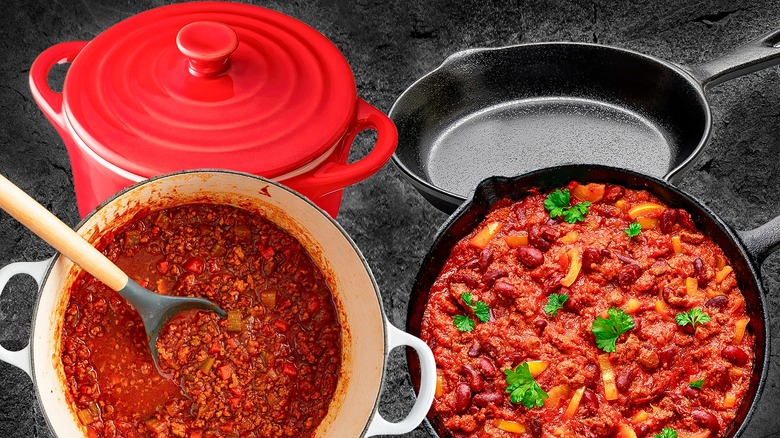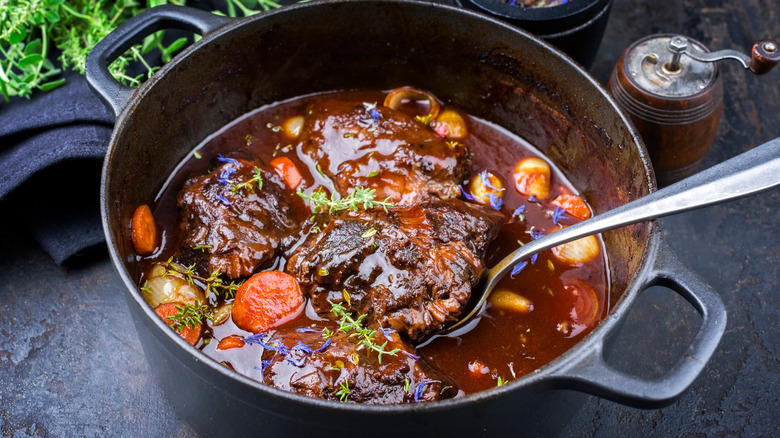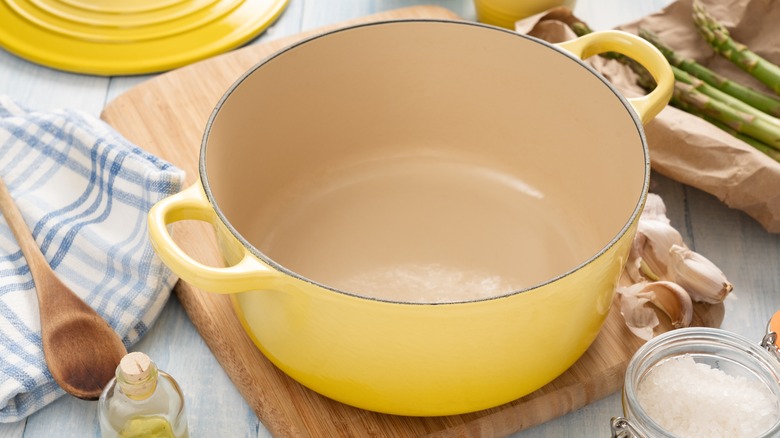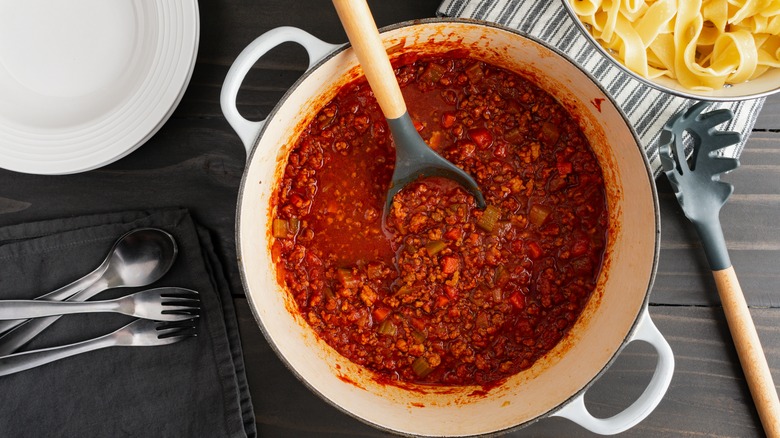The Major Differences In Cooking With Traditional Vs Enameled Cast Iron
Suppose you're in the market for a new Dutch oven or heavy skillet. In that case, you've undoubtedly noticed there are generally two options available: The traditional, dark, unfinished cast iron version and the more colorful, enamel-coated choice. Aside from aesthetics, there are a few differences to understand about using these long-lasting pieces of cookware that might influence your purchase.
The most obvious difference is in the care of the pan's finish — cast iron is a bit more finicky to clean and should be dried well and oiled after each use. But with good seasoning, the metal finish will be naturally non-stick, which is a great bonus. Enamel does not require seasoning and can be wiped dry for storage, but the enamel is subject to scratching if you scrub too hard or use metal utensils for cooking. The other major difference between styles — what can be cooked inside — is also related to the finish. Cast iron is reactive to acidic foods like tomato sauce, and the dark color can make it harder to see how brown sauce reductions and sweets like jam and caramel are turning. Light-colored enamel is visually easier for these dishes and won't react when acid foods are cooked inside.
What is traditional cast iron?
Traditional cast iron pans have been used for centuries — you might even see them passed down from generation to generation because they are so long-lasting. Unlike enameled pans, the bare metal surface cannot be damaged or scratched, and although the metal can rust, it can easily be restored with just some oil and heat. The iron can react with some foods, like acidic tomato or wine-based sauces, causing a slightly metallic flavor and a greyish tinge to light-colored sauces. However, with proper care, the surface will become less reactive and even nonstick, making it a breeze to cook on.
The durability of cast iron pans makes them useful for cooking over high heat, both on the stovetop and on a campfire or grill. You can heat a cast iron pan ripping hot to sear a steak, then pop it in the oven to finish. You can also slowly simmer braised beef, make a pan pizza, or bake artisan bread in the sturdy pans.
Washing your cast iron after cooking is not complicated; ignore the often-repeated myth that soap will harm your pan. The important part of cleaning is making sure your pan is bone-dry after washing, which is easy to do by heating it slightly after you've dried it with a kitchen towel. A quick swipe of oil while the pan is hot and dry will keep the surface from rusting and enhance the nonstick nature of well-seasoned cast iron.
What is enameled cast iron?
Enameled cast iron pans come in multiple sizes, from small skillets to large Dutch ovens, and a huge range of colors. The base iron metal is coated with a baked-on glassy surface inside and out that protects the metal from contacting food cooked in the pan. Enamel is not reactive, meaning it won't add any flavors to what you're cooking or rust if it's not completely dried. The super smooth surface is relatively non-stick, making your typical clean-up easy.
While enameled cast iron might sound easier to care for than traditional cast iron because the metal is protected from rusting, the surface still requires special care when cooking and cleaning. Most importantly, the enamel can be scratched and chipped if treated roughly. An enamel finish can crack if the empty pan is preheated on a stovetop because areas of the metal will heat up and expand at different rates. You should avoid using metal utensils to stir and scrape enameled cast iron to prevent scratches and discoloration.
You'll find enameled cast iron with both dark and white interior finishes. A light interior allows you to see color changes when you cook foods like caramel and roux, making it easy to see when you've reached the flavor point you want.
These two workhorse pans are sturdy but need different care
The main choice when deciding to cook with your cast iron or enameled iron pan comes down to the recipe and your preferences, there's really no wrong choice. Both types of pan are perfect for keeping heat even while simmering stews and braises, and both are compatible with stovetop and oven cooking methods.
Each finish has its advantages and challenges. An enameled cast iron pan is a breeze to clean. There's no need to heat the pan and season it before storing, and there's no worry if you'd like to soak it in the sink. Although the glossy enamel helps keep food from sticking, scratches, cracks, and chips can damage the finish and make the pan unusable. Traditional cast iron requires a bit of thought for everyday cleaning and care, but even the most mistreated, rusty pan can be brought back to perfection with some elbow grease. With good care, both pans can be used for a lifetime of cooking.



